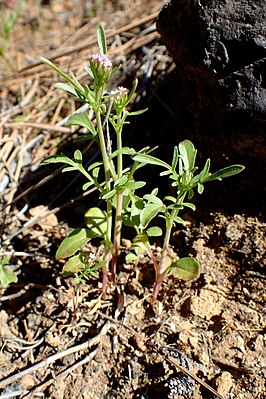Ankle spurflower
| Ankle spurflower | ||||||||||||
|---|---|---|---|---|---|---|---|---|---|---|---|---|

Ankle spurflower ( Centranthus calcitrapae ) |
||||||||||||
| Systematics | ||||||||||||
|
||||||||||||
| Scientific name | ||||||||||||
| Centranthus calcitrapae | ||||||||||||
| ( L. ) DC. |
The ankle spur flower ( Centranthus calcitrapae ) is a species of the genus of spur flowers ( Centranthus ) in the subfamily of the valerian family (Valerianoideae).
features
The foot angel spurflower is an annual plant that reaches heights of 10 to 40 centimeters. It is bare, blue-green and single-stemmed. The leaves are opposite. The lower leaves are up to 10 centimeters long, stalked, spatulate, blunt in front and notched or serrated on the sides. Towards the top, the leaves become more sedate and pinnate.
The flowers are arranged in partial inflorescences . These arise from the upper leaf axils and are terminal, sessile, forked and dense. The corolla is fused and pink. Your tube is up to 2 millimeters long and has a short spur in the middle. There are 5 unequal tips and a stamen . The ovary is subordinate. In the heyday the calyx is just a ring-shaped bulge. During the fruiting season, the feathery bristles belonging to the flightable fruit develop from it.
The flowering period extends from March to June.
The number of chromosomes is 2n = 32.
Occurrence
The ankle spurflower occurs from the Mediterranean region to Asia Minor. It grows on dry grass and wasteland. The original distribution area includes Madeira, Morocco, Algeria, Tunisia, Libya, Gibraltar, Spain, Portugal, France, Italy, the Balearic Islands, Corsica, Sardinia, Sicily, Croatia, Albania, Greece, Crete, the Aegean Sea, Turkey and the Ukraine. In the Canary Islands, the originality is doubtful. It is a neophyte in the Azores and Great Britain.
Taxonomy and name explanation
The basionym for Centranthus calcitrapae (L.) Dufr. is Valeriana calcitrapae L. Carl von Linné , who was the first to give the species this name, took over the name "foliis calcitrapae" from Caspar Bauhin , which means that the leaves are similar to those of the star knapweed ( Centaurea calcitrapa ). "Calcitrapa" is Latin and means the weapon an ankle or crow's foot. Centaurea calcitrapa has spines that look like a crow's foot. Centranthus has no such spines at all; the resemblance relates solely to the leaves.
literature
- Ehrentraud Bayer, Karl-Peter Buttler , Xaver Finkenzeller, Jürke Grau: Plants of the Mediterranean (The Colored Nature Guide). Mosaik Verlag GmbH, Munich 1986.
Individual evidence
- ↑ Centranthus calcitrapae at Tropicos.org. In: IPCN Chromosome Reports . Missouri Botanical Garden, St. Louis
- ↑ a b c d E. von Raab-Straube & T. Henning (2017+): Valerianaceae. - In: Euro + Med Plantbase - the information resource for Euro-Mediterranean plant diversity. Data sheet Valerianaceae
